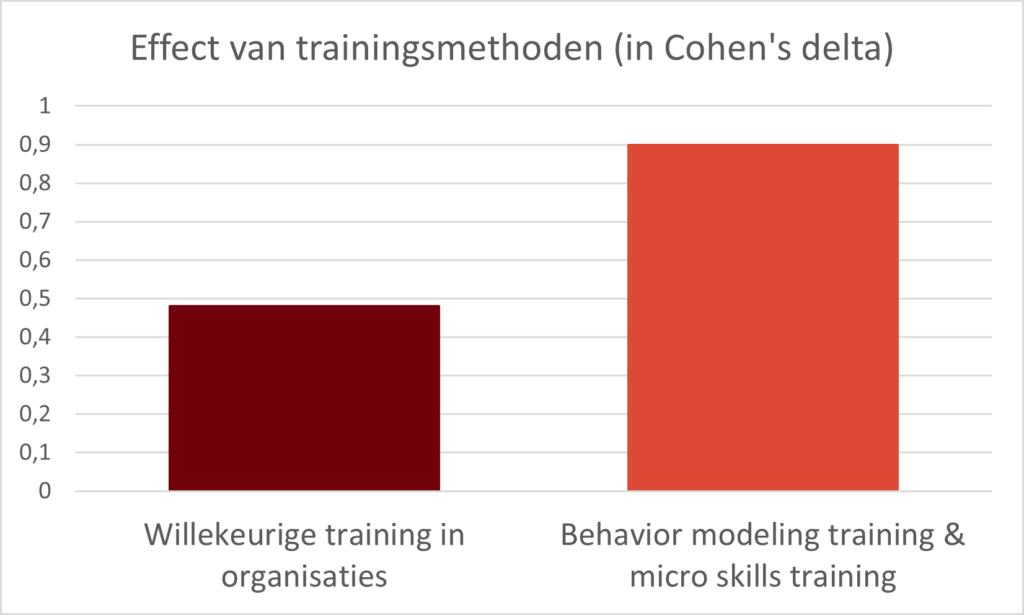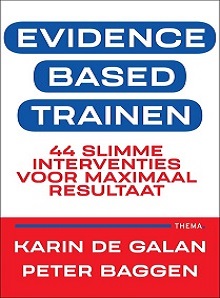Trainen kost tijd, geld en energie. En er zijn voortdurend keuzes te maken. De wetenschap kan ons daarbij helpen. Want er is veel onderzoek gedaan naar hoe mensen vaardigheden leren en hoe trainers dat proces kunnen ondersteunen. Daarom zijn we in het wetenschappelijk onderzoek gedoken. We hebben op een rij gezet wat goed onderbouwde leertheorieën zijn en welke interventies van trainers bewezen effectief zijn.
Trainen met veel of weinig resultaat
Sinds de jaren zeventig hebben veel wetenschappers de sociaal-cognitieve theorie van Albert Bandura gebruikt om te onderzoeken hoe mensen nieuwe vaardigheden leren en hoe je ze als trainer daar optimaal bij helpt. Dat heeft geleid tot twee nieuwe trainingsmethoden: behavior modeling training en micro skills training. Beide methoden zijn effectief. Vergeleken met een willekeurige training in organisaties hebben ze bijna twee keer zoveel effect (gemeten in Cohen’s delta).

Leren en trainen volgens Bandura
De leertheorie van Bandura en de trainingsaanpak die daaruit voortkomt, zijn gemakkelijk te begrijpen. Hieronder legt Karin uit hoe mensen vaardigheden leren en hoe je dus het beste kunt trainen. Ze start met een voorbeeld van een feedbacktraining: hoe beoordeel je die? Aan het eind pas je de theorie erop toe en zie je op welke punten je de training kunt verbeteren.
Glijbaan trap 2.0
Voordat we in het wetenschappelijk onderzoek doken hadden we al een eigen methode: de glijbaan en de trap. Die zijn ontstaan vanuit en bedoeld voor de trainerspraktijk. Terwijl we in de wetenschap doken hebben we de glijbaan trap stapje voor stapje verbeterd. Hieronder legt Karin uit hoe de 2.0-versie van de glijbaan-trap eruitziet.
Meer weten?

Wil je meer weten over de wetenschap achter onze methode? Lees dan ons boek Evidence based trainen. Net als alle andere boeken van Karin is het eenvoudig en praktisch geschreven – maar nu wél met de inbreng van onderzoeker Peter Baggen. Je leest hoe leertheorie van Albert Bandura in elkaar zit. Dat levert een praktisch trainingsmodel op met vier stappen. Daarna lees je een boel onderzoeken naar specifieke trainersinterventies. Die vertalen we door naar praktische tips voor trainers. Het boek sluit af met twee volledig uitgewerkte trainingsopzetten waarin veel evidence-based trainingsinterventies verwerkt zijn.
Bekijk hier het de eerste deel van Evidence based trainen.
Hier kun je het boek Evidence based trainen bestellen.
Artikel: wat Thalheimer niet vertelt over smile sheets
Een training evalueren door deelnemers te vragen naar hun waardering? Will Thalheimer vindt het verspilde moeite. Want, zo zegt hij, wat deelnemers vinden van een training heeft geen verband met wat ze geleerd hebben. Dat zou blijken uit maar liefs vier grote overzichtsstudies. Zijn conclusie: deelnemers naar hun reactie vragen is net zo goed als ‘een muntje opgooien om te bepalen of een training goed of slecht is. Serieus!’
Dit klinkt best overtuigend, maar klopt het ook? Nou nee, want als het gaat om deze meta-analyses slaat Thalheimer de plank flink mis. In werkelijkheid laten die zien dat reacties van deelnemers belangrijke informatie kunnen bevatten over trainingen. Het is dus tijd voor weerwerk. Daarom pluist Peter in dit artikel verder uit wat de meta-analyses die Thalheimer aanhaalt echt zeggen. En hij gaat na wat dat betekent voor evaluaties van trainingen door deelnemers.